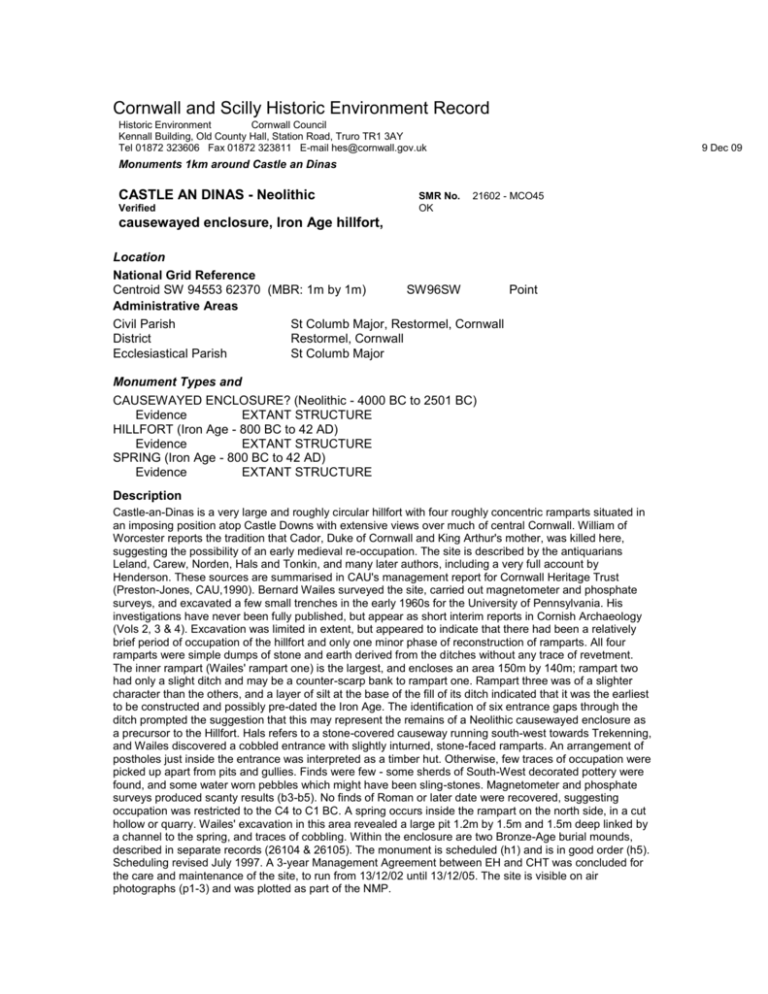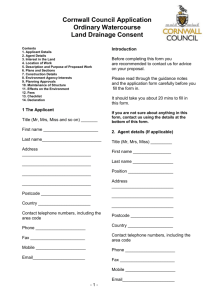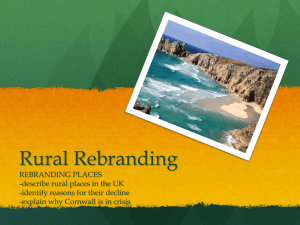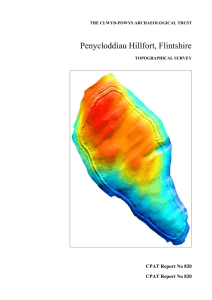CSHER-Castle-an
advertisement

Cornwall and Scilly Historic Environment Record Historic Environment Cornwall Council Kennall Building, Old County Hall, Station Road, Truro TR1 3AY Tel 01872 323606 Fax 01872 323811 E-mail hes@cornwall.gov.uk 9 Dec 09 Monuments 1km around Castle an Dinas CASTLE AN DINAS - Neolithic Verified SMR No. OK 21602 - MCO45 causewayed enclosure, Iron Age hillfort, Location National Grid Reference Centroid SW 94553 62370 (MBR: 1m by 1m) SW96SW Point Administrative Areas Civil Parish St Columb Major, Restormel, Cornwall District Restormel, Cornwall Ecclesiastical Parish St Columb Major Monument Types and CAUSEWAYED ENCLOSURE? (Neolithic - 4000 BC to 2501 BC) Evidence EXTANT STRUCTURE HILLFORT (Iron Age - 800 BC to 42 AD) Evidence EXTANT STRUCTURE SPRING (Iron Age - 800 BC to 42 AD) Evidence EXTANT STRUCTURE Description Castle-an-Dinas is a very large and roughly circular hillfort with four roughly concentric ramparts situated in an imposing position atop Castle Downs with extensive views over much of central Cornwall. William of Worcester reports the tradition that Cador, Duke of Cornwall and King Arthur's mother, was killed here, suggesting the possibility of an early medieval re-occupation. The site is described by the antiquarians Leland, Carew, Norden, Hals and Tonkin, and many later authors, including a very full account by Henderson. These sources are summarised in CAU's management report for Cornwall Heritage Trust (Preston-Jones, CAU,1990). Bernard Wailes surveyed the site, carried out magnetometer and phosphate surveys, and excavated a few small trenches in the early 1960s for the University of Pennsylvania. His investigations have never been fully published, but appear as short interim reports in Cornish Archaeology (Vols 2, 3 & 4). Excavation was limited in extent, but appeared to indicate that there had been a relatively brief period of occupation of the hillfort and only one minor phase of reconstruction of ramparts. All four ramparts were simple dumps of stone and earth derived from the ditches without any trace of revetment. The inner rampart (Wailes' rampart one) is the largest, and encloses an area 150m by 140m; rampart two had only a slight ditch and may be a counter-scarp bank to rampart one. Rampart three was of a slighter character than the others, and a layer of silt at the base of the fill of its ditch indicated that it was the earliest to be constructed and possibly pre-dated the Iron Age. The identification of six entrance gaps through the ditch prompted the suggestion that this may represent the remains of a Neolithic causewayed enclosure as a precursor to the Hillfort. Hals refers to a stone-covered causeway running south-west towards Trekenning, and Wailes discovered a cobbled entrance with slightly inturned, stone-faced ramparts. An arrangement of postholes just inside the entrance was interpreted as a timber hut. Otherwise, few traces of occupation were picked up apart from pits and gullies. Finds were few - some sherds of South-West decorated pottery were found, and some water worn pebbles which might have been sling-stones. Magnetometer and phosphate surveys produced scanty results (b3-b5). No finds of Roman or later date were recovered, suggesting occupation was restricted to the C4 to C1 BC. A spring occurs inside the rampart on the north side, in a cut hollow or quarry. Wailes' excavation in this area revealed a large pit 1.2m by 1.5m and 1.5m deep linked by a channel to the spring, and traces of cobbling. Within the enclosure are two Bronze-Age burial mounds, described in separate records (26104 & 26105). The monument is scheduled (h1) and is in good order (h5). Scheduling revised July 1997. A 3-year Management Agreement between EH and CHT was concluded for the care and maintenance of the site, to run from 13/12/02 until 13/12/05. The site is visible on air photographs (p1-3) and was plotted as part of the NMP. -------------------------------Site history: 1: 1956. UNKNOWN/DOE Sources Report generated by HBSMR from exeGesIS SDM Ltd. All material copyright © Cornwall Council 1987- 5: 1984. PAS/DOE(1) Iron Age spring Page 1 Bibliographic reference: Hals, W. 1740. The Compleat History of Cornwall. VOL 2, 63-64 -------------------------------- (p1) Cornwall Photo Record: CAU. 1980. ABP/F4/84/945615. (2) Unedited Source: UNKNOWN. 1---. UNKNOWN TITLE. W ANTIQUITY. VOL X, 5, 56 (p2) Cornwall Photo Record: CAU. 1980. ABP/F4/85/945615. (3) Bibliographic reference: Wailes, B. 1963. Excavations at Castle-An-Dinas: Interim Report. CA No 2. VOL 2, 51-55 (p3) Cornwall Photo Record: CAU. 1980. ABP/F4/86/945615. (4) Bibliographic reference: Wailes, B. 1964. Excavation News. CA No 3. VOL 3, 85 (5) Bibliographic reference: Wailes, B. 1965. Excavation News. CA No 4. VOL 4, 65 (6) Bibliographic reference: Preston-Jones, A. 1990. Castle-An-Dinas, its Conservation Above and Below Ground. (7) Unedited Source: BORLASE, WC. 1871. MSS AT RIC, TRURO, DATED 21/08/1871. Designations, Statuses and Scorings Associated Designations Scheduled Monument - CO93 Castle an Dinas Other Statuses and Cross-References Old SMR number (OS MAP and SMR_NO) - SW96SW 22 MORPH - 398.6.1 SITE_ID (old PRN) - 21602 Old OS number (OS MAP and OS_NO) - SW96SW 2 Active Active Active Active Active Ratings and Scorings Condition Condition Qualifier Survival B - Good Partial excavation B - 80%+ Land Use Associated Historic Landscape Character Records - None recorded Other Land Classes - None recorded Related Monuments - None Recorded Associated Finds FCO5821 VESSEL (Neolithic - 4000 BC to 2501 BC) FCO5822 SLING SHOT (Neolithic - 4000 BC to 2501 BC) POTTERY STONE Associated Events/Activities - None recorded Associated Individuals/Organisations - None recorded Report generated by HBSMR from exeGesIS SDM Ltd. All material copyright © Cornwall Council 1987- DCO1684







